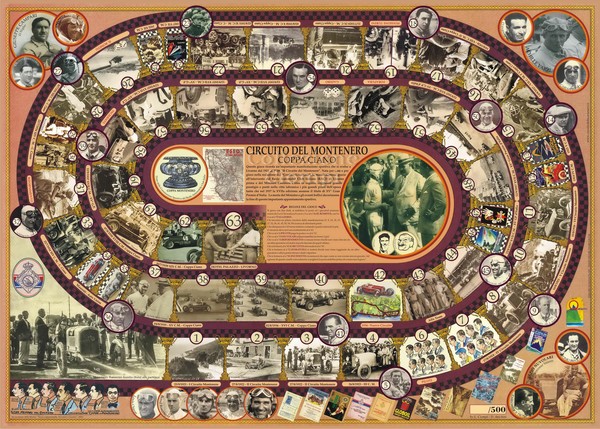
XVI° CIRCUITO DEL MONTENERO
COPPA CIANO
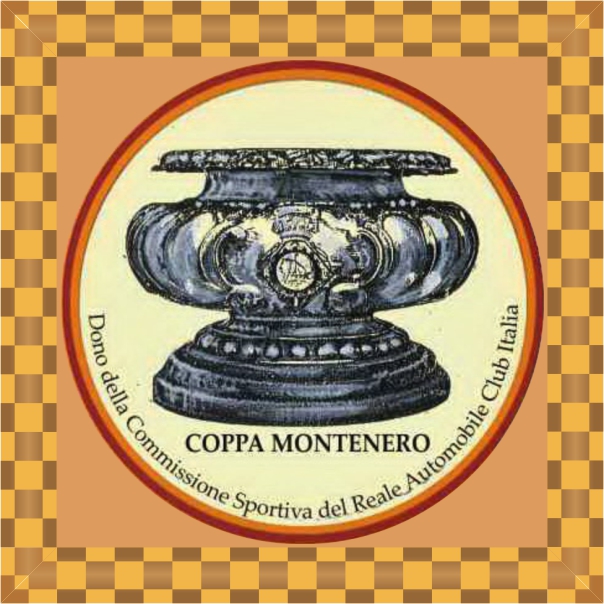
|
||
| Istituto luce |

|
XVI° CIRCUITO DEL MONTENERO
|

|
||
| Istituto luce |
| Introduzione | Articoli | Foto | Classifica e piloti |
Percorso | Pubblicità Pubblicazioni |
Coppa del Mare | Montenero Home |
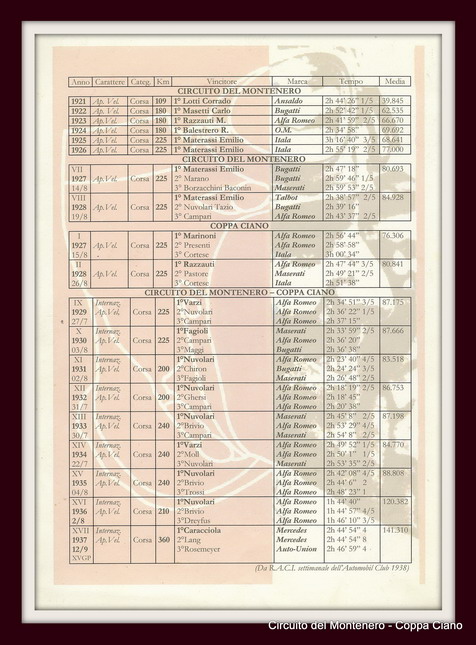
|
1936 - 2 agosto Percorso: Rotonda Ardenza Mare - Via della Torre - Ardenza Terra - Via del Littorale - Via Aurelia - Piazza Bartolomei (Antignano) - Via Aurelia (Miramare) - Via Amerigo Vespucci - Via Duca Cosimo - Piazza Dino Leoni - Piazza del Castello - Viale Vittorio Emanuele - Rotonda dell’Ardenza (lunghezza 7 km). “XVI Coppa Ciano” Formula Corsa oltre 1500 cmc (30 giri- 210 km) 1°) NUVOLARI Tazio - PINTACUDA Carlo, su Alfa Romeo in 1h. 44’.40” (media 120,382 km/h); 2°) BRIVIO Antonio, su Alfa Romeo, in 1h. 44’.57”.4/5; 3°) DREYFUS René, su Alfa Romeo, in 1h. 46’.10”.3/5; 4°) STUCK Hans-ROSEMEYER Bernd, su Auto Union, in 1h.47’.44”.1/5; 5°) CALAMAI Giosué, su Alfa Romeo, a tre giri. Giro più veloce il 22° di Nuvolari Tazio in 3’.23”.1/5 a 124,015 km/h. Vetturette 1500 cmc. (15 giri - 105 km) 1°) TROSSI Carlo Felice, su Maserati, in 58’.05”.2/5 (media 108,452 km/h); 2°) EMBIRICOS Nicholas, su ERA, in 59’.03”.4/5; 3°) VILLORESI Luigi, su Maserati, in 59’.13”.4/5; 4°) HARTMANN Laszlo, su Maserati, in 1h.01’.14”.2/5; 5°) ROVERE Luigi, su Maserati, in 1h.01’.53”; 6°) SEAMAN Richard, su Delage, in 1h.02’.32”; 7°) BERGAMINI Maris, su Maserati, a un giro; 8°) Mac EVOY Frederick, su Maserati a un giro; 9°) PROSPERI Agostino, su Maserati a un giro; 10°) PLATE’ Luigi, su Talbot a due giri; 11°) DE SANCTIS Gino, su Fiat a tre giri; Giro più veloce il 7° di Trossi Carlo Felice in 3’.48”.3/5 a 110,326 km/h. (Da: Maurizio Mazzoni: “Lampi sul Tirreno”, Firenze 2006) |
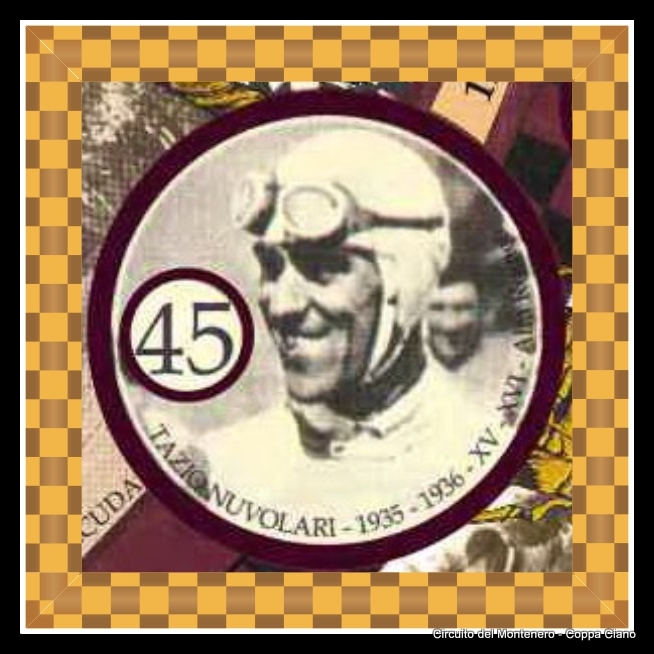
|
|
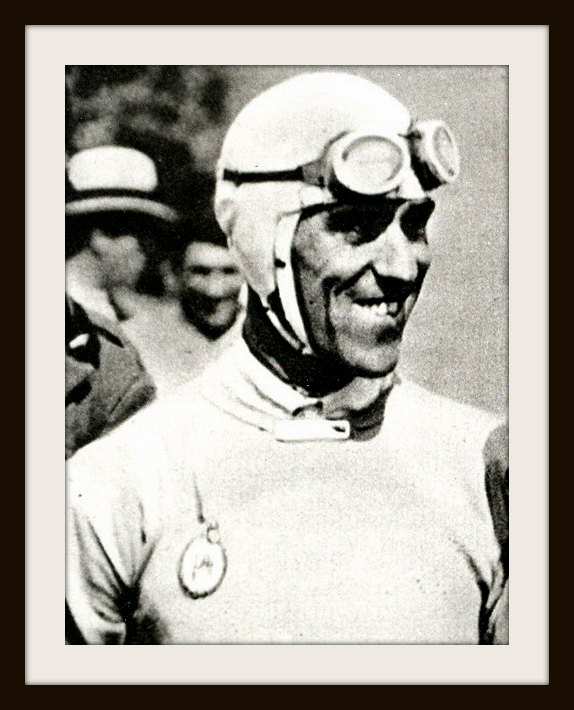
|
XVI CIRCUITO MONTENERO (X° COPPA CIANO) (Voiturette 1500cc + 1100cc) Livorno (Italia), 2 August 1936, - 15 laps x 7.0 km (4.35 mi)= 105 km (65.2 mi) Drivers (N°2) Alexander Todd, su Arkus-M.G. (DNA - did not appear); (N°4) Luigi Platé, su Talbot 700 - 1500cc; (N°6) Maris Bergamini, su Maserati 4CM - 1100cc; (N°8) Làszlò Hartmann, su Maserati 6CM - 1500cc; (N°10) Mario Colini, su Maserati 4CM 1100cc (DNA - did not appear); (N°12) Frederick McEvoy, su Maserati 6CM - 1500cc; (N°14) Luigi Villoresi su Maserati 4CM 1500cc; (N°16) Carlo Felice Trossi, su Maserati 6CM - 1500cc; (N°18) Nicholas Embiricos, ERA A - 1500cc; (N°20) Gino de Sanctis, su Fiat Balilla - 1000cc; (N°22) Ignazio Radice-Fosatti, su Maserati 4CM - 1500cc - (DNS - did not start); (N°24) Francesco Matrullo, su Fiat Balilla - 1000cc (DNA - did not appear); (N°26) Gino Rovere, su Maserati 4CM - 1500cc; (N°28) Reggie Tongue, su ERA B - 1500cc; (N°30) Vittorio Belmondo, su Maserati 4CM - 1500cc, (DNS - did not start); (N°32) Aldobrando Giannetti, su Fiat Balilla - 1000cc; (N°34) Agostino Prosperi, su Maserati 4CM - 1500cc; (N°36) Gianbattista Azzi, su Rocca-Fiat - (DNA - did not appear); (N°38) Richard Seaman, su Delage 15S8 - 1500cc; (N°40) Dioscoride Lanza, su Talbot 700 - 1500cc, (DNA - did not appear); (N°42) Ettore Bianco, su Maserati 4CM - 1500cc; Trossi wins as Seaman struggles The 1936 Coppa Ciano voiturette race was run to 1500cc formula. Seaman in his Delage led the first laps but then fell back due to fuel starvation and Trossi in his works Maserati dominated the rest of the event with Embiricos (ERA) second and Luigi Villoresi (Maserati) third. For the first time, the Coppa Ciano was held on the new Livorno circuit (see the GP report for more details). After having restricted the voiturette race to 1100cc during the the earlier years the formula was now changed to 1500cc. Entries: Richard Seaman's Delage had finally been repaired after the Picardie crash where the steering box had split. Giulio Ramponi had replaced the engine with a rebuilt one that gave 10 hp more than the old one. Seaman was held up at customs and could only take part in the final practice session. Final adjustments could not be made. There were two ERAs taking part, Nicolas Embiricos (R2A, grey) and Reggie Tongue (R11B, green with black and silver stripe). Their main opponents were the three Maserati 6CM with independent front suspension: Trossi's works car (#1531), Hungarian Lázló Hartmann's works car (#1532) and the one belonging to Australian born British playboy Frank McEvoy (#1535). The rest of the field consisted of five 4 cylinder Maseratis, Platé's old Talbot and two Fiat-Balillas. Race: The weather was uncertain. It had rained all night and the rain continued to fall during the morning. The start of the voiturette race was given at 3 p.m. by Mrs. Visconti, daughter of the Podestà of Livorno (Podestà was an official appointed by the fascist regime replacing the major). Grid (N°18) Embiricos su ERA (N°38) Seaman su Delage (N°16) Trossi su Maserati (N°14) L. Villoresi Maserati (N°26) Rovere su Maserati (N°?) (N°42) Bianco su Maserati (N°?) Seaman took the lead followed by Villoresi, Trossi, Bianco and Rovere. Embiricos had made a bad start from his position and had dropped to 8th. But soon the strongest cars were able to advance through the field and soon the order was Seaman, Trossi, Villoresi, Embiricos, Hartmann and Rovere. Seaman held the lead for the first laps but then the Delage started to suffer from fuel starvation due to a faulty air pressure pump. On the fourth lap Trossi took over the lead and held it to the end. A struggling Seaman was soon down to fourth position. Embiricos passed Luigi Villoresi but was unable to do anything against Trossi even though the ERA theoretically was faster than the Maserati. Seaman was passed by Hartmann and Rovere as well and ended up in 6th position. Results 1°(N°16) Carlo Felice Trossi su Maserati 6CM (laps 15) 58m.05.4s; 2°(N°18) Nicholas Embiricos su ERA A - 1500cc (laps 15) 58m.45.8s? (+ 50.4s); 3°(N°14) Luigi Villoresi su Maserati 4CM - 1500cc (laps 15) 59m.13.8s (+ 1m08.0s); 4°(N°8) Làszlò Hartmann su Maserati 6CM - 1500cc (laps 15), 1h.01m.14.4s (+ 3m.09.0s); 5°(N°26) Gino Rovere su Maserati 4CM - 1500cc (laps 15), 1h.01m.58.0s (+ 3m.52.6s); 6°(N°38) Richard Seaman su Delage 15S8 - 1500c (laps 15), 1h.02m.32.0s (+ 4m.31.6s); 7°(N°6) Maris Bergamini su Maserati 4CM - 1100cc (laps 14), 1h.00m.15.0s; 8°(N°12) Frederick McEvoy su Maserati 6CM - 1500cc (laps 14), 1h.00m.32.8s; 9°(N°34) Agostino Prosperi su Maserati 4CM - 1500cc (laps 14), 1h.01m.15.0s; DNF(N°42) Ettore Bianco su Maserati 4CM - 1500cc (laps 13), (engine); DNF(N°32) Aldobrando Giannetti su Fiat Balilla - 1000cc (laps 13); 10°(N°4) Luigi Platé Talbot 700 - 1500cc (laps 13), 1h.01m.04.0s 11°(N°20) Gino de Sanctis su Fiat Balilla - 1000cc (laps 12) 1h.00m.09.8s; DNF(N°28) Reggie Tongue su ERA B - 1500cc (laps 9). Fastest lap: Trossi (Maserati) on lap 7 in 3m.48.6s = 110.2 km/h (68.5 mph) Winner's medium speed: 108.5 km/h (67.4 mph) Weather: In retrospect: Information differs about Embiricos' finish time. Automobile Revue and Allgemeine Automobil-Zeitung (Berlin) say the time was 58m.45.8s. La Stampa and L'Auto on the other hand say 59m.03.8s and Paul Sheldon's black book suggests 59m.05.8s correcting two unnamed Italian sources that had claimed 58m.05.8s. Published errors are often contagious to several papers. Could winner Trossi's 58m.05.4s in this case somewhere have been copied in part to Embiricos' result? XVI° CIRCUITO MONTENERO (X° COPPA CIANO) Livorno (Italy), 2 August 1936 - 30 laps x 7.0 km (4.35 mi) = 210 km (130.5 mi) Drivers 42 Làszlò Hartamann, su Maserati 8CM - 3000cc - (DNA - did not appear); 44 Pietro Ghersi, su Maserati 6C-34 - 3700cc; 44 Carlo Felice Trossi, su Maserati 6C-34 - 3700cc - (DNS - altenative driver); 46 Clemente Biondetti, su Alfa Romeo Tipo B/P3 - 3200cc; 48 Achille Varzi, su Auto Union AG Auto Union C - 6000cc; 50 Antonio Brivio, su Alfa Romeo 12C-36 - 4100cc; 52 Giosué Calamai, su Alfa Romeo 6C -1750 -1800cc; 54 Bernd Rosemeyer, su Auto Union AG Auto Union C - 6000cc; 56 Tazio Nuvolari, su Alfa Romeo 12C-36 - 4100cc; 58 Manfred von Brauchitsch, su Daimler-Benz AG Mercedes -Benz W25K - 4700cc - (DNA - did not appear); 60 René Dreyfus, su Alfa Romeo 8C-35 - 3800cc; 62 Luigi Fagioli, su Daimler-Benz AG Mercedes -Benz W25K - 4700cc - (DNA - did not appear); 64 Carlo Pintacuda, su Alfa Romeo 8C-35 - 3800cc; 64 Francesco Severi, su Alfa Romeo 8C-35 - 3800cc - (DNS - altenative driver); 66 Hans Stuck, su Auto Union AG Auto Union C - 6000cc. Boy, did those Italians cheer? Three Auto Unions were challenged by four Scuderia Ferrari Alfa Romeos at the Coppa Ciano, held on a new circuit. Nuvolari (Alfa Romeo) had to retire immediately but he took over Pintacuda's car and started a wild chase on the field led by Varzi (Auto Union). Stuck (Auto Union) was also an early retirement and he took over Rosemeyer's car. The Auto Unions suffered from brake problems and Brivio (Alfa Romeo) and Nuvolari were able to catch Varzi and pass him. Varzi eventually had to retire and the Scuderia Ferrari drivers Nuvolari, Brivio and Dreyfus went on to an unsuspected triple victory. For the first time the Coppa Ciano was held on the new Livorno circuit, also known as the Circuito del Miramare. For safety reasons the whole Montenero mountain section of the course had been left out shortening the circuit from 20 km to some 7 km. On this course variant, rather than circling the rotunda the cars went through a hairpin and returned back on the west side before moving left and into the Ardenza district. Instead of climbing along Via di Montenero the route took the cars along the railroad before passing over it on the way through Antignano along the main street. South of Antignano after a sharp turn it joined the old race track back towards Livorno. Entries Daimler-Benz had initially entered two cars for Luigi Fagioli and Manfred von Brauschitsch but after the disastrous results at the German Grand Prix the team decided to miss Coppa Ciano and instead make preparations for extensive tests at Nürburgring, in an attempt to sort out the problems with their cars. Auto Union entered cars for their usual trio of Bernd Rosemeyer, Hans Stuck and Achille Varzi. The team was confident after their double victory at the German Grand Prix a week earlier so the cars arrived to Livorno straight from Nürburgring after only routine maintenance. Scuderia Ferrari entered four cars for the race, two V-12s for Tazio Nuvolari and Antonio Brivio and two 8-cylinder cars for René Dreyfus and Carlo Pintacuda, the latter now having returned from South America. It is possible the areas round the radiators were colour coded and in that case Pintacuda's would probably have been white but this is pure speculation. Clemente Biondetti was to race Ghiocomo di Rahm's Tipo B Alfa Romeo (#50010) under the Scuderia Maremmana banner and Pietro Ghersi a 6-cylinder Maserati for Scuderia Torino. The start list also included amateur driver Giosuè Calamai from nearby Florence in an old Alfa Romeo 6C-1750. Race Despite the uncertain weather, it had rained all night and the rain continued to fall at intervals during the morning, a record crowd turned up for the 16th Coppa Ciano. Enzo Ferrari has said that a racing driver gets a second slower when he gets married. At Coppa Ciano Rosemeyer was more than a second slower. Having been married for less than three weeks his wife was flying from Berlin to Istanbul with her Messerschmitt Bf108 "Taifun" preparing herself for a record flight that she had planned for months and Rosemeyer was visibly stressed and worried. Auto Union team manager told Rosemeyer not to do anything foolish but rather retire if he did not feel well. Once the voiturette race had finished the cars were lined up for the main event with Nuvolari's Alfa in the middle of the first row with the Auto Unions of Rosemeyer and Varzi on each side. Grid (N°48) Achille Varzi (Auto Union-3m.22s?) (N°56) Tazio Nuvolari (Alfa Romeo-3m.26s) (N°54) Bernd Rosemeyer (Auto Union-3m.25s) (N°50) Brivio (Alfa Romeo-3m.30s) (N°66) Stuck (Auto Union-3m.28s) (N°46) Clemente Biondetti (Alfa Romeo-3m.42s) (N°64) Pintacuda (Alfa Romeo-3m.40s) (N°60) Dreyfus (Alfa Romeo-3m.32s) (N°52) Calamai (Alfa Romeo-3m.58s) (N°44) Ghersi (Maserati-3m.51s) At the start Rosemeyer led the field into the first hairpin but soon Varzi took over the lead followed by Rosemeyer, Brivio, Stuck, Dreyfus, Pintacuda and Biondetti. To the terrible disappointment for the spectators Nuvolari was out with a broken differential on his 12-cylinder Alfa Romeo only seconds after the start. Nuvolari run back to the pits and demanded a new car. The team was naturally hesitant to bring in Brivio but when Nuvolari made it clear he wanted an 8-cylinder car instead of the V-12 Pintacuda was called in after two laps and Nuvolari took over, returning to the race some 40s behind the leader Varzi, who was followed by Stuck and Rosemeyer with Brivio already 10s behind. On the third lap Stuck, going through the narrow and twisty Antignao town section of Livorno, hit a curb stone and damaged his car so much he had to retire. After four laps the race order was Varzi, Brivio, Dreyfus, Nuvolari, Biondetti and Rosemeyer. Rosemeyer had a much uninspired race and retired after 6 laps. Rosemeyer admitted that he was so nervous that he could not race so Stuck took over the car. Varzi was doing 3m.27s laps, Brivio 3m.29s and Nuvolari 3m.30s. After seven laps Varzi had opened up a 17 seconds gap to Brivio with Dreyfus third. But now the Italian spectators were cheering and jumping for joy as Nuvolari was driving one of his greatest races. The narrow twisty sections were fitting the Mantuan and the 8-cylinder Alfa perfectly. On the 12th lap Ghersi retired his Maserati with engine problems while Biondetti obstinately defended his fifth position against Stuck. As Nuvolari on the same lap caught Dreyfus, the French driver turned over to the right waving by his team mate. On the 14th lap Varzi was leading Brivio by 23 seconds but the Auto Union driver was in trouble with the brakes. At half distance he situation was: 1. Varzi (Auto Union) 52m.33s; 2. Brivio (Alfa Romeo) 52m.47s; 3. Nuvolari (Alfa Romeo) 52m.58s; 4. Dreyfus (Alfa Romeo) 53m.17s. After 16 laps the gap from Varzi to Brivio was down to 12s and to Nuvolari 20s but by now Varzi's rear left wheel brake was locking up badly. The spectators were standing and cheering. On the 19th lap Varzi, Brivio and Nuvolari appeared together. On the next lap Nuvolari passed both opponents to take the lead while Varzi came into the pit with brake failure. After a 1m10s stop Varzi returned to the race only to retire after one or two more laps. Brivio in the stronger V-12 car took the lead from Nuvolari on lap 21 opening up a 200m gap but on the next lap Nuvolari was back in the lead after having made 3m.32.2s, the fastest lap of the race. Brivio got a sign from the pit that the cars should remain in those positions. Nuvolari despite not having any more opposition kept on going very fast. Scuderia Ferrari dominated the last third of the race. The "Flying Mantuan" led the Ferrari team home in 1-2-3 positions and took one of his greatest and most popular victories, once again humiliating the opposition. Stuck finished fourth, 3 minutes behind the winner and Calamai finished fifth and last. During the summer of 1936 Nuvolari probably raced better than ever in his career, beating the German teams four times within two months (Penya Rhin, Milan, Budapest and Coppa Ciano). Results: 1°(N°64) C. Pintacuda/T. Nuvolari ,Alfa Romeo 8C-35 -3800cc (30 laps) 1h.44m.40.0s; 2°(N°50) Antonio Brivio, Alfa Romeo 12C-36 - 4100cc (30 laps) 1h.44m.57.8s (+17.8); 3°(N°60) René Dreyfus, Alfa Romeo 8C-35 - 3800cc (30 laps)1h.30m.10.6s (+1.30.4); 4°(N°60) B. Rosemeyer/H. Stuck, Auto Union C - 6000cc (30 laps) 1h.47m.44.2s (+3.04.2s); 5°(N°52) Giosuè Calamai, Alfa Romeo 6C-1750 -1800cc (27 laps); DNF(N°48) Achille Varzi, Auto Union C - 6000cc (22 laps) (brakes); DNF(N°46) Clemente Biondetti, Alfa Romeo Tipo B/P3 - 3200cc (14 laps) (mechanical/engine?); DNF(N°44) Pietro Ghersi, Maserati 6C-34 - 3700cc (12 laps) (engine); DNF(N°66) Hans Stuck, Auto Union C - 6100cc (4 laps) (mechanical); DNF(N°56) Tazio Nuvolari, Alfa Romeo 12C-36 - 4100cc (0 laps) (transmission); Fastest lap: Tazio Nuvolari (Alfa Romeo) on lap 22 in 3m.23.2s = 124.0 km/h (77.1 mph) Winner's medium speed 120.4 km/h (74.8 mph) Weather: In retrospect After this race Rosemeyer sent his famous telegram to his wife in Damascus: "Nach der sechsten Runde aufgegeben. Komm bald. Du darfst mich nicht wieder allein lassen." (Gave up after six laps. Come [home] soon. You must never leave me alone again.) While Rosemeyer returned to Berlin with Lufthansa his mechanics did not have such comfort on their way to Auto Union factory in Zwickau via the Brenner Pass and Munich. Ludwig Sebastian: "We took the ordinary train from Rome but were unable to find any seats and had to stand in the corridor." Elly Beinhorn-Rosemeyer dedicated a whole 14 page chapter in her book Mein Mann der Rennfahrer on her flight clearly showing how important it was for her. Her idea was to fly over three continents starting from Damascus and ending up back in Berlin in a single day. On 2-3 August she therefore flew from Berlin via Budapest and Istanbul to Damascus to get herself in the correct position. The 2 August flight had indeed been an adventurous one as she had been forced to do instrument flying without radio in rain clouds over the Czech mountains. On Thursday 6 August she finally made the three continents flight starting at Damascus in darkness and continuing to Cairo, Athens and Budapest to reach Berlin in the evening. The headline "Boy, did those Italians cheer?" is a quote from Motor Sport September 1936. Footnote 1. The 1936 race course was very similar to the 1937 one that had a length of 7.218 km (4.485 mi) but it seems there exact length of the 1936 course is unknown. Results speeds were given using a course length of 7 km, giving a race length of 105 km for the voiturette race and 210 km for the Grand Prix, but 7.2 km should probably be closer to the correct value. Primary sources researched for this article: -Allgemeine Automobil-Zeitung, Berlin; - AUTOMOBIL-REVUE, Bern; - La Stampa, Torino; - L'AUTO, Paris; - Motor Sport, London; (by Leif Snellman in: The Golden Era of Grand Prix Racing) |